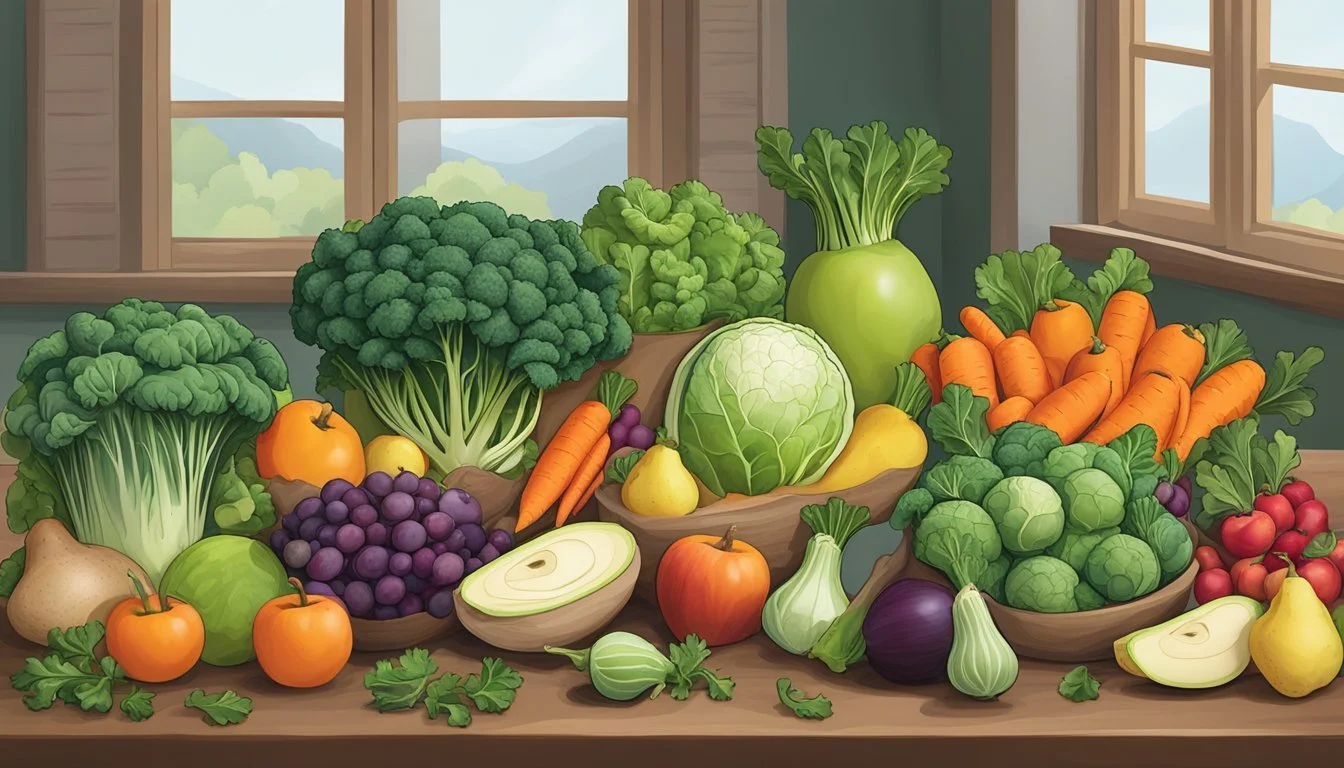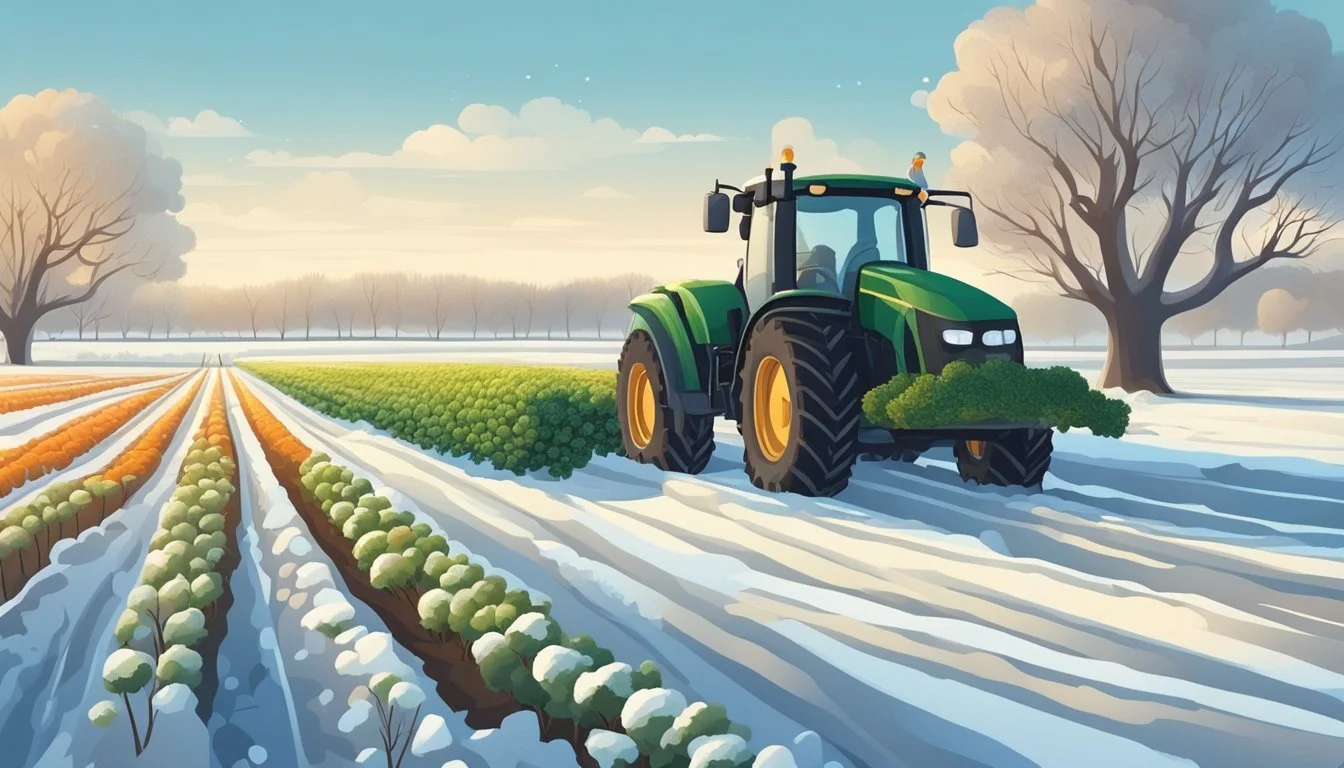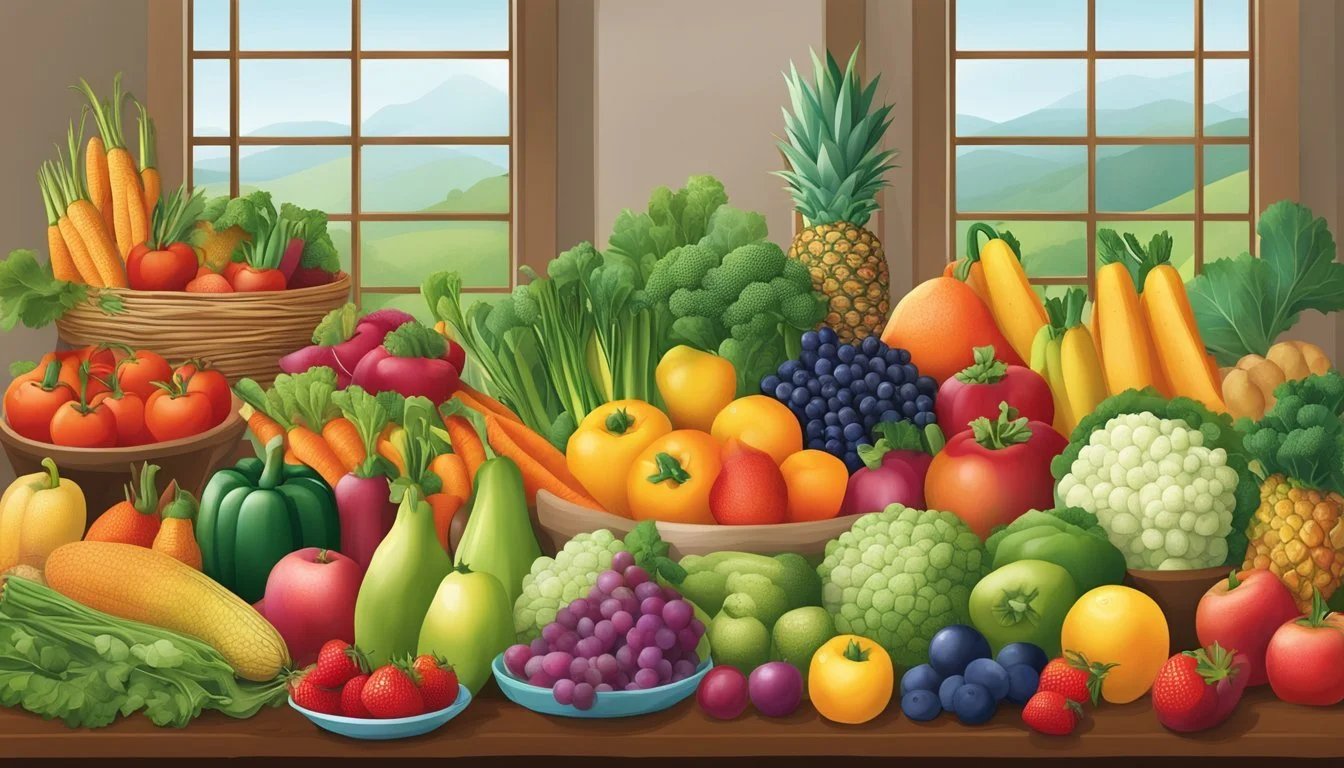Washington Seasonal Fruit & Vegetables Calendar in January
Your Guide to Fresh Produce
This Article is Part of our Washington Seasonal Fruit & Veg Calendar
Washington State, renowned for its lush landscapes and diverse climate, boasts a vibrant agricultural scene, yielding a rich variety of fruits and vegetables even in the heart of winter. January in Washington offers a specific selection of produce that can withstand the cooler temperatures, ensuring that local consumers continue to have access to fresh, nutrient-rich options during this season. Root vegetables and hearty greens take center stage, capitalizing on their natural ability to endure the colder weather.
Seasonal eating not only supports local farming and reduces the carbon footprint associated with long-distance transportation but also aligns with the natural growing cycle of produce. In January, Washingtonians can find an array of winter crops, such as beets (how long do beets last?), which continue to be available through January due to their resilience in the ground. These earthy vegetables, along with varieties like carrots and potatoes, often make their way to farmers’ markets and grocery store shelves during these cooler months.
In addition to root vegetables, some storage crops, such as apples and pears that were harvested in the fall, remain available thanks to controlled cold storage techniques that extend their freshness. While the selection of fresh produce in January may not be as abundant as in the summertime, these storage methods and winter-harvested crops ensure a continuous supply. The availability of these fruits and vegetables provides opportunities for wholesome and seasonal culinary experiences throughout the winter in Washington.
Overview of Washington's Seasonal Produce
In January, Washington's seasonal produce is influenced by its mild winter climate, and residents often turn to these local offerings for fresh, nutrient-dense options.
January Climate Influence on Crops
Washington's January weather is characterized by cooler temperatures and precipitation, which plays a significant role in determining the type of seasonal produce available. The state's diverse climate zones allow for the growth of various winter crops. Root vegetables and hearty greens thrive in these conditions, as they can withstand colder weather and even improve in flavor after a frost.
Root Vegetables: Beets, carrots, and potatoes
Leafy Greens: Kale, (What wine goes well with kale?) Swiss chard, and collard greens
Brassicas: Brussels sprouts and cabbage
Importance of Seasonal Eating
Eating seasonally in Washington supports not only local farmers but also favors a more sustainable approach to consumption. Seasonal produce tends to be fresher, tastier, and more nutritious. Additionally, it often has a lower carbon footprint due to reduced transportation and storage needs.
Freshness: Seasonal produce is harvested at its peak and doesn't require long storage periods.
Nutrition: Vegetables and fruits consumed during their appropriate seasons are richer in vitamins and minerals.
Economic Support: Choosing local, in-season items bolsters Washington's agricultural economy.
By focusing on these seasonal offerings, Washingtonians can enjoy produce that is at its best both in flavor and nutritional content.
January Seasonal Fruits in Washington
In January, residents of Washington have the opportunity to enjoy a variety of seasonal fruits. Despite the cold climate, a range of hardy tree fruits and citrus fruit varieties are available during this month, often sourced from cold storage or winter-hardy varieties.
Citrus Fruits Varieties
Citrus fruits are not typically grown in Washington's January climate, but they are commonly available in markets due to imports. Consumers can find a variety of oranges, tangerines, and grapefruits. These fruits add a burst of vitamin C and brightness to the winter months.
Hardy Tree Fruits
Winter is the season for apples and pears, which have been harvested in the fall and kept in cold storage to maintain freshness. Washington is renowned for its apple varieties, such as:
Fuji: Crisp texture with a sweet flavor.
Granny Smith: Known for its tartness and firm flesh.
Pears are also enjoyed for their delicate sweetness and include varieties such as:
Anjou: Both green and red, juicy, with a hint of tanginess.
Bosc: Characterized by its firm texture, making it ideal for baking and cooking.
Availability of Berries
Berries are typically out of season in January, with most varieties not available until spring or summer. However, Washington’s markets may offer greenhouse-grown or imported kiwi fruits, providing a taste of summer with their bright flavor and high vitamin content.
January Seasonal Vegetables in Washington
January in Washington brings with it a variety of vegetables that thrive in the cooler climate. Root vegetables and tubers are at their peak, leafy greens and brassicas offer a bountiful harvest, and alliums like leeks are readily available.
Root Vegetables and Tubers
In January, Washington’s soil yields an abundance of root vegetables and tubers. Staples such as potatoes are versatile and widely available in many varieties, including russets and fingerlings.
Carrots: Sweet and earthy, perfect for soups and stews.
Beets: Deep reds and golden hues, rich in flavor and nutrients.
Turnips and rutabagas: Less common but delicious, with a peppery kick.
Leafy Greens and Brassicas
This month also offers a selection of leafy greens and brassicas. These vegetables are known for their nutritional value and hardiness in colder temperatures.
Kale: Curly or flat-leaf, this hearty green is ideal for salads and sautés.
Squash: Though commonly associated with autumn, varieties like butternut can still be found.
Alliums Availability
Alliums, such as leeks, are still prominent in January. They bring mild onion-like flavors to a range of dishes and are a key ingredient in hearty winter recipes.
Leeks: Thick, white stems with a gentle sweetness when cooked.
Farming Practices for January Produce
In January, Washington farmers continue to cultivate a selection of produce that can withstand the colder temperatures. Their methods depend on the type of farming practices they employ, whether organic or conventional.
Organic vs Conventional
Organic farming in Washington State adheres to practices that maintain soil quality without synthetic fertilizers and pesticides. In January, farmers may use crop rotation and cover crops to enrich the soil for the upcoming seasons. They protect cold-hardy crops like kale and root vegetables from harsh weather using natural methods such as mulching and the use of organic, biodegradable films for soil warmth and moisture retention.
Conventional farming practices may involve the use of chemical fertilizers and pesticides to support growth and protect the crops in the cold season. Conventional farmers might use greenhouses or hoop houses to extend the growing season for certain produce such as winter greens and hearty vegetables, which require a more controlled environment during January's unpredictable weather patterns.
Local Farms and Agriculture
Local farms contribute significantly to Washington's agricultural sector, especially in the supply of seasonal produce. They may implement a mix of organic and conventional practices, tailored to their specific environmental conditions. In January, local farms focus on sustainably maximizing yield through techniques like:
Soil preparation: Enhancing soil fertility with organic compost or manure.
Pest management: Employing integrated pest management (IPM) strategies that may combine organic and sustainable methods to keep crop damage to a minimum.
Harvesting: Selectively harvesting winter crops, like certain varieties of apples and pears that can be stored from fall or those vegetables that can tolerate frost.
Local agriculture in Washington benefits from a strong tradition of community-supported agriculture (CSA) programs, where consumers directly purchase shares of produce from the local farms. This allows for a transparent connection between consumer and farmer, and it encourages best practices in farming throughout the year, including the winter months of January.
Shopping and Storage Tips
When venturing out to buy produce in January in Washington, understanding how to select the best fruits and vegetables and the proper ways to store them ensures both longevity and quality.
Selecting the Best Produce
One should look for fruits and vegetables that are firm to the touch and have a vibrant color, indicative of freshness and peak ripeness. For example:
Apples: Choose ones with firm, unblemished skins.
Pears: Select pears that are firm but give slightly to pressure at the stem end.
In the vegetable aisle:
Celery: (how long does celery last?) Look for crisp stalks and fresh, green leaves.
Chicory: The leaves should be bright and not wilted.
Storing Fruits and Vegetables
Different fruits and vegetables require different storage methods to maintain their quality. A few specifics include:
Apples: Store in a cool, dark place or refrigerate in a perforated bag to retain moisture.
Pears: Keep at room temperature until ripe, then refrigerate.
Vegetables have varying needs:
Celery: Wrap in aluminum foil and refrigerate to keep crisp.
Chicory: Place in the crisper drawer of the refrigerator, loosely wrapped in a damp paper towel.
Preparing Seasonal Dishes
January brings with it a bounty of Washington's root vegetables and hardy greens, laying a foundation for dishes that embody the essence of winter comfort. The season's produce inspires a multitude of warm, nutritious recipes.
Cooking with Root Vegetables
Root vegetables like parsnips, potatoes, and turnips are at their peak, offering earthy flavors and nutritional benefits. To maximize their natural sweetness, one can roast these vegetables at high heat with a drizzle of olive oil and a sprinkling of herbs. For an extra layer of flavor, roasting alongside Washington's winter garlic and onions introduces a caramelized complexity to these dishes.
Roasted Root Vegetable Recipe:
Ingredients: parsnips, potatoes, turnips, garlic, onions, olive oil, salt, pepper, thyme.
Instructions: Chop vegetables, coat with olive oil and seasonings, and roast at 425°F until tender and golden.
Winter Salads and Dressings
The winter season does not preclude the enjoyment of salads, especially when crafted from hearty greens such as kale and chicory that stand up well to bold dressings. Adding roasted root vegetables to these greens along with a vinaigrette made with zesty lemons or limes, gives the salad a balance of warm and cool elements.
Winter Salad Recipe:
Base: kale, chicory.
Toppings: roasted parsnips, walnuts (how long do walnuts last?), dried cranberries (how long do dried cranberries last?).
Dressing: lemon vinaigrette (lemon juice, olive oil, honey, salt, pepper).
Hearty Soups and Stews
Winter in Washington is the perfect time for chefs to employ seasonal produce in comforting soups and stews. Ingredients like mushrooms, cauliflower, and broccoli add heartiness to vegetarian dishes (What wine goes well with vegetarian dishes?), while the incorporation of beef or chicken can satisfy those seeking a richer fare. Slow cooking these elements allows for an infusion of flavors and a warming eating experience.
Hearty Vegetable Stew Recipe:
Ingredients: mushrooms, cauliflower, broccoli, carrots, stock (vegetable or chicken), herbs, salt, pepper.
Instructions: Sauté vegetables, add stock and herbs, simmer until vegetables are tender.
Health Benefits of Seasonal Eating
Eating fruits and vegetables that are in season can lead to numerous health benefits. Seasonal produce often boasts a higher nutritional value due to being harvested at the optimal time for flavor and vitamin content. Such produce is fresher, as it likely has a shorter time from harvest to table, and this freshness often translates to more antioxidants and vitamins for the consumer.
For instance, Washington's January seasonal fruits and vegetables may include:
Apples: Rich in fiber and vitamin C
Pears: Good source of vitamin K and fiber
Winter Squash: High in vitamins A and C
Here are key health benefits associated with consuming seasonal produce:
Enhanced flavor: Seasonal fruits and vegetables are picked at their peak; they taste better and may encourage people to eat more produce.
Cost savings: In-season produce tends to be more affordable due to lower transportation and storage costs.
Environmentally friendly: Local, in-season produce generally requires less transportation, reducing carbon footprint.
Consuming seasonal produce also means that one's diet varies throughout the year, potentially leading to a broader intake of essential nutrients, which can benefit overall health and well-being. Additionally, seasonal fruits and vegetables might help in combatting and preventing health conditions, such as heart disease and certain types of cancer, by providing essential vitamins, minerals, and antioxidants.
Monthly Seasonal Produce Calendar
In January, Washington's produce selection is limited due to the cold climate. However, consumers can still enjoy a range of fresh, seasonal items.
What to Expect Each Month
January in Washington presents a narrower variety of produce due to winter conditions. Here’s what is typically available:
Root Vegetables: Carrots, beets, and potatoes store well and are often available.
Winter Squash: Types like butternut or acorn squash may still be in stock from the fall harvest.
Leafy Greens: Hardy greens such as kale and chard can survive the cold and are typically available.
Apples and Pears: Stored from the fall, these fruits remain crisp and flavorful.
Mushrooms: Foraged varieties like chanterelles may be found, weather permitting.
Planning Your Shopping List
A shopping list for January’s seasonal produce in Washington could look like this:
Vegetables:
Kale
Swiss chard
Beets
Carrots
Potatoes
Fruits:
Stored apples
Pears
Others:
Onions
Garlic
Winter squash
Mushrooms (if available)
Consumers should note that market availability can vary based on weather and specific regional conditions.









